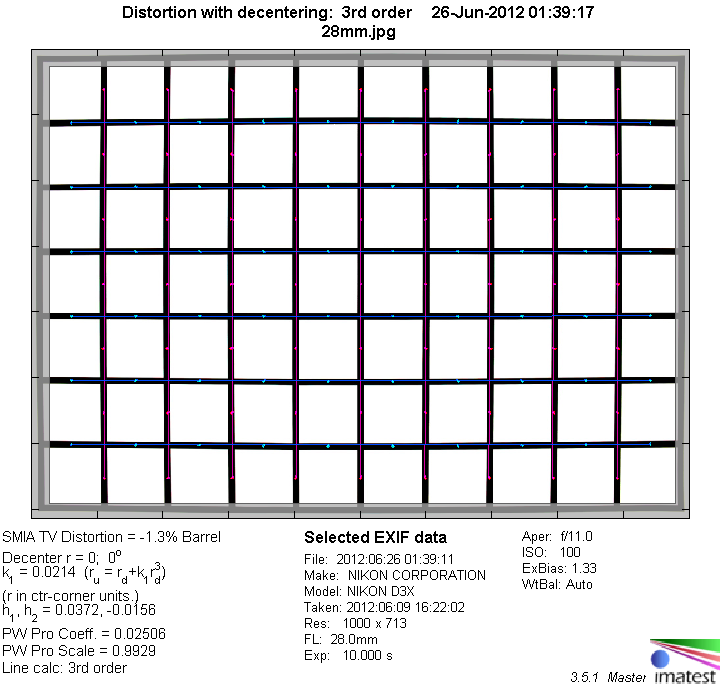|
Page 2 of 3

Distortion
The lens shows a moderate amount of barrel distortion with a minor amount of mustache subtype towards the extreme corners. This can be visible in critical shots especially with straight lines near the image borders. However, the distortion is almost uniform and easy to correct in post processing.

The chart above has a real-world size of about 120x80cm.
Vignetting
It's typical for fast primes to show a pronounced amount of light fall-off towards the corners, nonetheless the Nikkor suprises with a higher than expected amount in this regard. Wide open, the corners darken a lot. As usual stopping down reduces the issue, but even at rather small apertures there is still half a stop of vignetting left.
We're performing our vignetting analysis based on
(uncorrected) JPEGs straight from the camera. The JPG engine of the Nikon D3x features a rather flat
gradation curve, thus has a moderate contrast characteristic, resulting in comparatively low vignetting figures - the
corresponding Canon figures are roughly 40% higher due to the more
aggressive default contrast setting.

MTF (resolution)
The lens delivers very good resolution across the frame wide open already. Stopping down lifts the center resolution to excellent until diffraction takes its toll at f/11 and beyond.
The borders and corners show mostly very good resolution thoughout the tested aperture range, with (just) excellent figures stopped down to f/5.6 and f/8. For most of the aperture range, the extreme corners show slightly better performance than the image borders.
Please note that the MTF results are not directly comparable across the different systems!
Below is a simplified summary of the formal findings. The chart shows line widths
per picture height (LW/PH) which can be taken as a measure for sharpness.
If you want to know more about the MTF50 figures you may check out the corresponding
Imatest Explanations

Chromatic Aberrations (CAs)
Chromatic aberrations (color shadows at harsh contrast transitions) range from 1.3 to almost 1.6 pixels at the image borders throughout the tested aperture range. This might be visible in very large prints (or crops). However, CAs can easily be corrected in software or by the camera itself (most modern Nikon DSLRs remove CAs themselves if you shoot JPGs).

Bokeh
One of the primary usage scenarios for a large aperture lens is to separate the main subject from the background. In such an image the quality of the bokeh (out-of-focus blur) is of major significance.
Except for the transition zone, where image blur can be somewhat nervous, the lens delivers quite smooth bokeh, especially for a wide-angle lens.
Background highlights are cut-off due to mechanical vignetting towards the image borders at large apertures. They do show only a small amount of outlining, but suffer a little from bokeh fringing (see next section).

Bokeh Fringing
Bokeh fringing (non-coinciding focal planes of the various colors) is a common issue with relatively fast glass. As you can
notice below, the halos have different colors - magenta (red + blue) in front the focus point
and green beyond. Truly "apochromatic" lenses don't show this kind of fringing but these lenses are very rare especially
below 100mm. Unlike lateral lateral CAs, bokeh fringing cannot easily be fixed in post processing.
Typical for most fast primes, the AF-S 28/1.8 shows some amount of fringing at large aperture settings, which can of course be reduced by stopping down.
These shots also illustrate that the lens does not suffer from focus shift when stopping down (focus shifts are not uncommon for fast prime lenses). This is true not only for very short focus distances (as in the shots below) but also for larger subject distances.
|